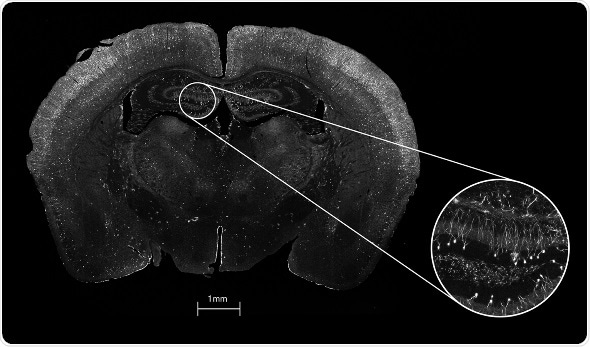Oct 5 2016
Caliber I.D. launches the RS-G4, a new class of modular confocal microscope that delivers confocal's expected high resolution and clean contrast while overcoming its limited scan areas.
Scanning large areas at lightning fast speeds, RS-G4 dramatically cuts the time required for efficient study of next-generation large format samples including brain slices, plant cross-sections, or large fields of cells or tissue critical for high-throughput screening.

Figure 1. Neurons activated during stress test. Caliber ID's RS-G4 scanned and stitched 1050 fields to image this 12mm x 8mm brain section (0.5" x 0.25") in just 270 seconds (4.5 minutes), with confocal resolution and clarity (inset). Subject: Mouse Brain. Objective: 40x/1.30 oil immersion. Image courtesy of Boston Children's Hospital, D. Ehlinger and K. Commons.
Consider the attached image of a whole mouse brain (Figure 1). The RS-G4 scanned and stitched 1050 fields to image this 12mm x 8mm area (approximately 0.5" x 0.25") in just 270 seconds (4.5 minutes), approximately one-tenth the time required by other currently-available systems. Yet, as demonstrated by the inset, the image retains all the confocal detail and resolution offered by the 40x/1.30NA oil immersion objective.
The cornerstone of RS-G4's innovative performance is its high-speed strip mosaic imaging. On the hardware side, continual stage movement is coordinated with the resonant scanning of the confocal microscope.
Simultaneously, a proprietary stitching algorithm assembles and aligns mosaic strips with pixel level resolution. Hardware and software control are integrated under an easy-to-use, intuitive GUI.
Adding a new laser launch opens opportunities for fluorescence excitation at 405nm, 488nm, 561nm, 640nm and, critical for deep tissue neuroscience, 785 nm. In addition, the RS-G4 can collect large area 3D image stacks that can be readily imported by any conventional processing package such as Image J or Imaris. Surprisingly, all of this capability comes in a small 18" x 15" footprint.
"We at Caliber are thrilled to be launching this revolutionary product (the RS-G4) into the research market," said Robert Kelley, Caliber I.D.'s Vice President of Sales."For researchers, this increased scan speed means greater productivity and shorter time to publication."
Caliber I.D.'s RS-G4 with the new multi-laser launch will be running samples in BOOTH# 130 at the annual meeting of the Society for Neuroscience, November 12-16, in San Diego, CA.
Source: Caliber ID